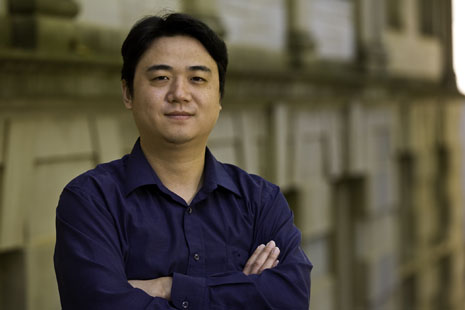Building Ultra-Low Power Wireless Networks
FAYETTEVILLE, Ark. – Engineering researchers at the University of Arkansas have received funding from the National Science Foundation to create distortion-tolerant communications for wireless networks that use very little power. The research will improve wireless sensors deployed in remote areas where these systems must rely on batteries or energy-harvesting devices for power.
“Ultra-low power consumption is one of the most formidable challenges faced by the next generation of wireless sensing systems,” said Jingxian Wu, assistant professor of electrical engineering. “These systems will need to operate without interruption for multiple years and with extremely limited battery capacity or limited ability to scavenge energy from other devices. This is why the NSF was interested in our research.”
Ultra-low power wireless communication devices are powered by batteries or energy harvesting devices such as solar panels. The lower the power consumption, the longer the device can operate without recharging. This is especially important for wireless sensor networks, where the sensors are often deployed in remote areas to monitor items such as water quality, the health of animals and the condition of tunnels, buildings and bridges. These networks are expected to operate without interruption over extremely long periods of time without changing batteries. Therefore, it is important to reduce the power consumption so the device can operate for long periods without human intervention.
During data transfer, distortion occurs if the received message is different from the transmitted message. In digital communication systems, the data are transmitted in the form of zeroes and ones. Due to noise and interference during the transmission process, the receiver might receive a zero when a one was transmitted or vice versa. Some critical data or software, such as computer games, requires distortion-free communication. With these systems, any distortion might make the software nonoperational. Other data, such as pictures, music and videos, can tolerate some distortion because human perception might not be sensitive to some of the features.
Conventional research on wireless communication technologies focuses on minimizing distortion through various methods and designs. Conversely, Wu and doctoral student Ning Sun work with distortion-tolerant systems. Rather than limiting or minimizing distortion, their wireless systems allow for controlled distortion, which requires less power than conventional technologies.
“If we accept the fact that distortion is inevitable in practical communication systems, why not directly design a system that is naturally tolerant to distortion?” Wu said. “Allowing distortion instead of minimizing it, our proposed distortion-tolerant communication can operate in rate levels beyond the constraints imposed by Shannon channel capacity.”
Shannon channel capacity is the maximum rate at which distortion-free information can be transmitted over a communication channel.
The goal of Wu’s research project generally is to advance the knowledge of ultra-low power wireless networks. He and his colleagues will construct and test theories, design tools to enable distortion-tolerant technologies and design and develop prototype networks. Their theories exploit the unique features of wireless monitoring systems, such as delay-tolerance, distortion-tolerance, low data rate and spatial data correlation, all of which provide more freedom in network design.
The researchers’ work will accelerate the widespread deployment of ultra-low power wireless networks used for surveillance, environmental and structure monitoring, and biomedical sensing. These applications have the ability to provide early warnings to prevent catastrophic events, such as structural failures, to improve public safety and homeland security and to promote the health and well being of the general public.
The National Science Foundation grant totals $279,425 over three years.
Wu and Sun recently published findings on distortion-tolerant wireless networks in IEEE Transactions on Wireless Communications.
Contacts
Jingxian Wu, assistant professor, electrical engineering
College of Engineering
479-575-6584,
wuj@uark.edu
Matt McGowan, science and research communications officer
University Relations
479-575-4246,
dmcgowa@uark.edu
Headlines
Walker Foundation Creates Merlin and Beverly Augustine Endowed Scholarship
The Willard & Pat Walker Charitable Foundation furthers commitment to students and educational access with a $200,000 gift to establish the Merlin and Beverly Augustine Endowed Scholarship Fund.
Critic and Editor Cathleen McGuigan to Speak at Fay Jones School 2024 Spring Commencement
McGuigan, former editor in chief of Architectural Record, will deliver the Fay Jones School of Architecture and Design's 2024 Spring Commencement address on May 11.
Walton College Students Win Big at 2024 Sales Competition
For three days this past April, beginner and advanced sales students from Sam M. Walton College of Business at the U of A showcased their most persuasive pitches, competing in the bi-annual sales competition.
International Nursing Honor Society Inducts New Members
Sigma Theta Tau, an international honor society for nurses, administrators, educators, researchers, policymakers and entrepreneurs, inducted 28 new members in a ceremony on April 14.
U of A Uptown Campus Fondly Remembers John Griffith
Griffith passed away on April 19, 2024. He joined the university in 2002 and served uptown's facilities management needs with endearing humor, wit and kindness.





